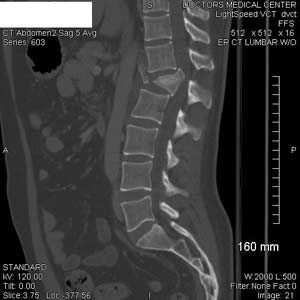 Photo Robert Donovan A CT scan shows a severe compression fracture at L1. A large fragment of the vertebrae has been shoved backwards, and spinal cord compression is prominent. |
I live in the Central Valley of California, and you know that summertime has officially arrived when the temperature readings are in the 90s and even over 100 at times. To cope with such heat, the masses like to head toward the easily accessible wide patchwork of rivers and reservoirs of the Sierra Nevada mountain range.
In a season full of sunshine and warm weather, I inevitably see an increase in injuries resulting from outdoor activities. Based on my experiences, I’d like to share what I hope to be some useful lessons in treating (and hopefully preventing) associated injuries.
The Scene
Formula #1: Testosterone + Alcohol + H20 = Stupid Decisions
A young male travels to the Sierras with some friends to escape the heat and enjoy the cool waters. Born of high-altitude snowfall, the icy waters flow into various reservoirs. A classic suspension bridge looms over an especially quiet and inviting river, beckoning. What could be more exciting than a quick dip with a launch from the bridge?
He climbs over the rail, and finds himself airborne moments later. As he plunges toward the water, he thinks, “Boy, this is taking longer than I thought!”
Hitting the river feet first, the young man immediately experiences pain in his back, and loses sensation from the waist down and most of his lower extremity strength. With help, he is moved to the shoreline. Great pre-hospital care follows, with rapid assessment, stabilization, and transport. Because the distance to the hospital is substantial and the extent of both potential and real injuries has yet to be assessed, air transport is employed.
Pre-hospital Care
Extrication of a patient from a water environment — especially with a suspected or actual spinal injury — is problematic and takes great skill. Fortunately for the male, the EMS team possesses a rich array of water rescue expertise, and the patient is assessed, packaged, and transported to the nearest trauma center, at which I serve as an emergency physician. The team has paid meticulous attention to spinal stabilization and repositioning. In addition, the EMS team’s preliminary neuro exam was invaluable to our subsequent re-examinations.
The ED
The flight brings the patient to us — a Level 2 Trauma Center — and the flight team report triggers a trauma alert.
A well-run trauma resuscitation is an awesome sight to behold. If done correctly, professionals will perform an ABCDE, FAST Ultrasound Exam, chest x-ray, quick neuro exam, and carefully slip the patient off the backboard — all within 10 minutes! I examine his back and find that the patient has tenderness as I palpate the spinous processes in the mid-back area. A rectal exam shows no rectal tone and saddle numbness. Labs, foley, and myriad tasks are rapidly completed.
The patient is then transported to the 64-slice CT scanner where he gets a CT of the head, chest, abdomen and pelvis and a CT of the entire spine with reconstruction.
The CT indeed confirms what was expected: a severe compression fracture at L1. (See picture.) A quick look at the CT reveals that a large fragment of the vertebrae has been shoved backwards, and the cord compression is obvious. These observations are also confirmed with an emergency MRI. No other internal injuries are found. Once a “standard,” giving steroids in the face of spinal cord trauma is no longer a preferred treatment.
Fortunately, frequent neuro exams show slight improvement in sensation and indicate that motor strength is improving slightly. Trauma Services then admits the patient, with the neurosurgical team by its side. Surgery is performed, and the patient is finally discharged, albeit with permanent neurological injuries (surprisingly, he can at least walk with assistance).
Physics of the Jump
Formula #2: Velocity of a jump = SQRT (2 x g x height)
Many people speak of “terminal velocity” with the idea that it is one set speed for anything falling through the air. In reality, that’s not accurate. Each object in free fall will initially accelerate until it reaches a speed where the force of gravity is balanced by the oppositely vectored force of air resistance. If there is increased air resistance, then the final speed reached by a falling object will be slower.
For humans, falling in the classic parachute jumper’s position (flat, back arched, arms and legs extended) will result in a speed of around 120 miles per hour. However, if jumping head or feet first, the surface area exposed to the oncoming wind is less, so the final speed (“terminal velocity”) is greater, about 200 mph.
A useful bit of trivia for use as a pick-up line at bars is that this “head-first terminal velocity” is about the same maximum speed that a peregrine falcon can reach in a dive.
We can thus estimate our jumper’s final (feet first) speed with some rough math through formula #2.
Velocity = SQRT (2*32ft/ sec2*100 ft.), or roughly 80 feet/second. This is about 55 miles per hour!
Whether we are dealing with falls or motor vehicle accidents, the factor that often kills us is not how fast we are going, but rather, how quickly we decelerate. To highlight that point, while landing in a jet we approach the runway near 150 mph, and in 20 seconds, we are near a standstill — feeling fine. Yet, if we tried decelerating from that same speed over a shorter time — say 0.5 seconds — we would be in a world of hurt.
The rate of deceleration is the key to the injury. Water is a fascinating medium. At slow speeds, it is easy to slip quietly in without causing a ripple, but if we enter at more rapid speeds, it acts like concrete.
Take-home Lessons












